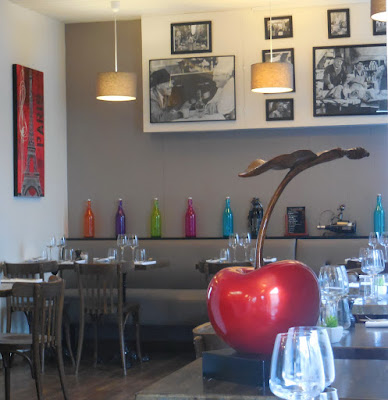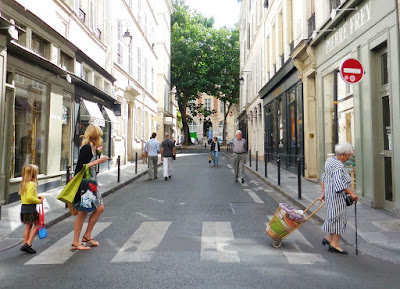August 29, 2016 -- Spectacularly beautiful Sundays are the days we love best
for walking along the left bank of the Seine.
We began our trek with a stroll down the picturesque rue Rouelle to the flowery
Square Bela Bartok. After a short walk
along the Quai de Grenelle, we were able to descend the steps to the riverbank
at the Pont de Bir Hakeim.
 |
| View of the right bank from the left bank, looking at the Place de la Concorde. |
As we walk past particular places or scenes, I remember things
that happened there – either to us, or to people we’ve read about. When I walk along that Quai de Grenelle near
the tall buildings of the Front de Seine, I think about the Princess, or so she
was called by the residents of the area.
She was a homeless lady who we used to see on the rue Linois, before the
new Beaugrenelle mall was built. When she first came to Paris to find work, she was a beautiful young lady from Brittany. She became a secretary
in a government agency, and then she became an escort, who was able to live
lavishly in a nice apartment facing the Seine, along the Quai de Grenelle.
Bad things happened, and then she was homeless. She angrily refused help when it was
offered. Finally, after decades of her living on the street, social workers found
that one of her suitcases was full of cash that she’d saved. Finally, she was moved into a nice assisted
living facility on the edge of the city. She resisted at first, but then she adapted.
 |
| The police headquarters and Notre Dame, as seen from beneath the Pont St. Michel. |
So, stories like that are constantly popping up in my memory
and in our conversation as we walk along.
I see the Pont de Bir Hakeim and I think of all the wedding
photographs we’ve seen taken there.
As we walk along the Seine, I remember the hard, gritty
industrial look that the FranPrix loading dock and the gravel and sand depot
had. Now, those facilities are still
present, but they’ve been trimmed back and tidied up as their turf has been
opened up to pedestrians and bicyclists as part of the Berges de Seine
pedestrianization project. Still, it
seems odd to have these gritty facilities in the middle of the city, on the
waterfront.
 |
| A new wall mural along the Seine's left bank. |
We pass under the Pont de l’Alma and I remember when the frayère was created there – it is a
little scoop taken out of the Seine under the bridge, to create a shallow,
shaded area for fish spawning.
I remember the big, bold statues that stood for a few years
along the Port de la Bourdonnais, near the Eiffel Tower. Looking across the river, we see the flame
statue on the Place de l’Alma, and we think of Princess Di and how she died in
the tunnel beneath that place.
We enjoy all the fun amenities that have been added to the riverbank in
recent years. Particularly, we enjoy the
vegetation – much of which has been planted in large wooden planters
interspersed with built-in benches. We
love seeing people using the benches and game tables for Sunday afternoon
picnic lunches with their family and friends.
We notice all the new wall murals and remember ones from the
past.
As we pass by Notre Dame, we remember the funky Six-Huit
bar/café/boat that used to be moored there.
How did such a shoestring operation get such a prime mooring place? It is still a mystery to us. Now, this is where the elegant Maxim dinner
boat is moored. That’s more like what
one would expect to see there, in such a prized location.
 |
| View of Notre Dame from the place where the Maxim boat is moored. |
We often stopped for refreshments on the Six-Huit, as we now
do on the Rosa Bonheur near the Pont Alexandre III. But we will
probably never board the Maxim dinner boat.
For dinner, we’re to be found at a land-based restaurant.
Since it was Sunday and we were out and about at mid-day,
and since we’d already walked for an hour and a half, we had decided to climb
the ramp to the street level as we passed the Musée D’Orsay.
Strolling by the Caisse des Depots (next to the museum), I
peeked through a window to see the statue by a French sculptor named Jean
Dubuffet – something I remembered from
a similar walk on July 19 of last year. When I see it, I also remember that there is a
Lichtenstein sculpture deeper inside the building.
Then, at the corner of the rue de Bac and the Quai Voltaire,
we see the big brasserie and restaurant, La Frégate. We enter, because we are hungry.
Appropriately, the server asked us if we wanted to dine in
the bar/terrace or in the restaurant.
Tom answered, “Le restaurant, s’il
vous plait.”
 |
| Dining room at La Fregate. |
At La Frégate, the two are very different. The bar/terrace menu is classic brasserie –
and quite informal. The restaurant menu
is classic, fine French food.
We were given a prime window seat at 1PM. Most diners were out on the terrace. We almost had the dining room to ourselves,
but soon a few other tables were occupied by other families or couples out for
their Sunday dinner. The view of the Louvre
and people walking across the Pont Royal is lively.
We ordered the charcuterie
platter (about 10 euros) to share as a starter, and then we each had Sole Meunière
– a bargain (in Paris) at 29 euros.
We were ravenously hungry, and the charcuterie cut the hunger pangs down efficiently. The platter held variety of saucisson sec cut into thin slices, a
little Parma ham, small samples of two kinds of terrine, a few tasty cornichons (gherkins), all accompanied
by a basket of traditional baguette slices.
Tom also indulged in butter. We
relaxed.
When the two plates of Sole arrived, we were almost
speechless. These looked exactly as they
should. Perfect, we thought. When the servers asked if we wanted them to
debone the fish for us, we each answered “merci
non, je le fais.” Of course they do
not know that we’re from Florida and we know our way around fish. I like to debone the sole myself because I
retain more of the fish on my plate than the servers do; they generally leave
too much on the bones, so that they can have a neater result.
 |
| A place where graffiti is encouraged on the left bank. |
I poured the clarified butter over the fish and steamed
potatoes, added a little salt and pepper, and voila! This is a Sunday
dinner to live for.
Tom ordered ice cream for dessert. It was so good that he thought it must be
Berthillon. Tom asked about the
brand. It was something else, not
Berthillon, and we couldn’t quite understand the name. It must be a small operation, like Queenie’s
on Sanibel Island.
La Frégate is beautiful and historic – dating back to 1870.
Its lovely interior – with trompe l’oeil
frescos on the ceiling, a stained glass wall, dark wood panels, and Art Nouveau light fixtures –
is what a traditional Parisian restaurant should be. Owned by M. et Mme. Couderc, the place has
had recent infusions of money for deep cleaning, restoration, and replacement
of the awning on its extensive façades, along the quai and the rue. I searched and searched, but could not find
the name of the chef. The man we saw who
looked like he might well be the chef was perhaps Vietnamese or Cambodian in
ethnicity, about 50-some years old.
Whoever the chef may be, he’s doing a fine job.
 |
Franprix containers on a barge, waiting to be loaded onto trucks,
right in the middle of Paris. (Franprix is a grocery chain.) |
I have another fond memory of a Sunday dinner at La Frégate one
year when we were similarly tired and hungry from walking. That time, the weather was cool, and I
ordered the blanquette de veau. Now I always think of that particular dinner
when I hear or read the words blanquette
de veau. In my mind, that was the
perfect example of that classic dish. The blanquette de veau
is still on the menu at La Frégate.
The first time we stopped at La Frégate, many years ago, my
expectations were low but we were tired and thirsty. The place was looking a bit tattered, and I thought any
brasserie in such a location must be a tourist trap. That first time, we had the brasserie fare,
and I’m sure it was good. But it is the
restaurant food that is so notably perfect and, well, classic.
If you go to La Frégate for dinner, you should make a
reservation. You can use
Lafourchette.com or Thefork.com to do so.
But for lunch, a reservation may not be necessary.
 |
| Thomas Jefferson statue with the Musee D'Orsay in the background. |
After this Sunday feast, we walked on down to the Pont de l’Archeveche,
where we turned the other direction on the rue Maitre d’Albert to reach the
Boulevard Saint Germain. Turning right
toward the metro stop, we passed through the triangle of green on the north
side of the Place Maubert.
There, memory
struck again. I remarked to Tom, as I
always do in that spot, “They burned Protestants here.” A tall, scholarly looking man walking nearby
turned in surprise to glance at me.
Maybe he is surprised that anyone knows or thinks of this anymore. Tom responded to me, “Well that was a long
time ago.” I said, “That’s true.” And we
descended into the metro station.
In the evening, I just ate a little green salad and Tom
snacked on various things. Then we went
out for a stroll in the evening air.
Down the avenue Emile Zola we went, almost to the very end. There we were in the midst of people and
restaurants of Middle Eastern persuasion.
At the plaza where the rue de Javel intersects, we turned back up the
Avenue to go home.
So ended a full day of 22,000 steps and lots of memories!


















































